Let’s cut straight to the chase. Who invented the HRV (helium release valve)?
Doxa enthusiasts say the valve was co-developed between Doxa and Rolex but it was Doxa who introduced it first to the general public in 1969 with the Doxa 300 T Conquistador, two years before Rolex officially introduced the Rolex Sea-Dweller to the market.
Most Rolex enthusiasts probably do not even know about this. They will wave the existing patent filed by Rolex on November 6, 1967 and claim the true inventor of the helium release valve was Rolex.
Who is right? This is yet another one of those cases that requires some serious separation of facts from fiction.
First things first. The existing Rolex patent (CH492246) does not mention Doxa nor any person related to Doxa. As far as the document goes, there is no evidence Doxa co-developed the valve with Rolex and shared the patent.
Link to patent: Montre étanche (CH492246)
.
An interesting detail stated on the patent is the name of the inventor: André Zibach. This is quite a famous name in the horological world. Before working with Rolex in the 1960s, André Zibach was one of the most renowned Patek Philippe watchmakers.
The idea for the Rolex valve goes back to Bob Barth, the famous US Navy SEALAB Aquanaut and pioneer in saturation diving.

.
To overcome nitrogen narcosis, a dangerous alteration of consciousness which kicks in at depths beyond 100 ft/30 m while breathing compressed air, Dr. George Bond of the US Navy developed the concept of Saturation Diving.

.
Instead of breathing regular air, the divers inhaled gas mixtures with high amounts of helium and became completely saturated with the gas. Helium atoms are very small and can penetrate watch cases through the seals, especially during prolonged exposure in dry underwater habitats or decompression chambers.

.
During the process of decompression to return the divers safely to normal surface pressure, it occured that helium accumulated inside a watch case could not escape fast enough. The pressure inside the watch, now much higher than on the outside, caused the crystals to pop off.
In an interview conducted by Rolex scholar Jake Ehrlich of Rolexmagazine.com with top Rolex USA executive T. Walker Lloyd, the Rolex manager recounted how Bob Barth told him about the phenomenon of exploding watches and how it could be avoided by using a valve. He and Bob Barth were dive buddies at the time. T. Walker Lloyd approached Rolex with Bob’s simple yet brilliant idea and was immediately hired as Rolex’s Oceanographic Consultant.
When their patent was granted on June 15, 1970, Rolex began promoting the Sea-Dweller to professional divers with a special program. In return for test reports and photographs showing the watch in action, the divers received the Rolex Sea-Dweller in loan.
Please note that in the above letter, the Sea-Dweller gifted to the diver (2.1 mil, Patent Pending) is referred to as prototype.
Read more: Important Rolex “Double Red” Sea-Dweller
.
In late 1971, as mentioned in the letter, Rolex started a cooperation with the French diving company Comex. From then on, all tests were carried out exclusively by Comex divers. The Sea-Dwellers that had been given in loan to professional divers were gifted to said divers. Around the same time, Rolex officially introduced the Sea-Dweller to the public.
An interesting detail concerning the patent is that it took almost two and a half years to be granted. Normally, this process takes around one year. Some have speculated the delay was caused by a dispute between Rolex and Doxa but after looking at other patents from the same period – for instance Omega’s ingenious crown for the Omega Seamaster 600 Ploprof (CH503310) – it becomes evident that particularly in 1967/68, the Swiss Patent Office was overwelmed with patent applications which ultimately led to enormous delays.
When it comes to the Doxa valve, most of the information put forth by Doxa enthusiasts appears to originate from interviews conducted with Urs Alois Eschle, a former Director of Doxa:
“The unexpected overwhelming success motivated me and the rest of the team to continue improving the DOXA SUB, so we continued to collaborate with Mr. Claude Wesly, to who tested the first Helium release valve equipped diver watch made by DOXA on his famous 30 day expedition on the Red Sea, at the same time Rolex® was working on their helium release valve equipped watch. Due to the good relationship between both companies, the decision was made to share the patent for the first Helium release equipped diver watch in 1968. In 1969, DOXA introduced the first helium release valve equipped diver watch “DOXA SUB300T Conquistador”. Rolex® followed in 1971 and introduced the Rolex® Submariner® Sea Dweller.”
Link to interview: Interview with the Doxa Sub designer (doxa300t.com)
.
The 30-days expedition in the Red Sea Urs Eschle was referring to in this interview is Jacques Cousteau’s famous Précontinent 2 or Conshelf 2, an experiment which took place in 1963 to prove man’s capability to live under the sea for prolonged periods of time.
The main habitat (Starfish House) was located in shallow water at 36 ft/11 m of depth.
The atmosphere in the Starfish House consisted of compressed air with the double amount of oxygen. No helium was used here.
A second and considerably smaller habitat, the Deep Cabin, was placed at a depth of 90 ft/27 m. It was here where Jacques Cousteau tested the principles of saturation diving developed by Dr. George F. Bond (US Navy SEALAB) for the first time under real life conditions.
Two of Cousteau’s Oceanauts spent an entire week in the Deep Cabin, breathing a helium-nitrogen-oxygen mixture. Since none of them was Claude Wesly, one cannot help but wonder how Mr. Wesly was able to test the prototype mentioned by Urs Eschle if he was not exposed to a helium atmosphere in the first place. Perhaps he gave the watch to one of the two divers involved in the experiment?
Précontinent 2 is well documented in Jacques Cousteau’s 1964 movie World Without Sun. At 14:40 of the following video, Jacques Cousteau mentioned the names of the two men participating in the Deep Cabin experiment: Raymond Kientzy and Andre Portlatine.
.
In this movie, the two divers swam back to the Starfish House (57:45) after being saturated with helium for one week. They did not decompress in a pressure chamber as would have normally been the case. Decompression of the watch would have occured during this trip to the Starfish House while submerged. From a logical point of view, the story put forth by Urs Eschle is not very plausible.
Apparently, there are two Doxa prototypes from 1965 in existence that feature a helium release valve.
One of these watches features also the patented double-scale bezel which combines the usual elapsed time (60 units) with maximum time at depth for ascending without decompression (no-deco) according to US Navy/Marine Nationale diving tables.

.
Doxa filed the Swiss patent for this interesting bezel on April 14, 1967 (CH489048), almost six months before Rolex filed their patent application for the valve.
Link to patent: Montre de plongeur (CH489048)
This is another patent from the same period of time that took an eternity to be granted, three years to be precise.
If the double-scale bezel already existed in 1965, why did Doxa wait another two years to secure their invention and risk that someone else could come up with a similar idea?
À propos similar idea, the picture below shows an Eterna Super KonTiki Ref. PTX130/5 with no-deco bezel made specifically for the Italian Marina Militare in 1965. See the small dots at the inner edge of the insert? Those marks are the usual 5 minutes calibration of regular diving bezels, making this a double-scale insert too. The question is, who invented the double-scale bezel really?
As implied above, it does not make much sense to come up with a great idea and wait another two years to secure it.
The same applies to the helium release valve. If it was ready when the patent for the double-scale bezel was filed in early 1967– as suggested by the existence of the above pictured prototype – why did Doxa not secure the valve idea in the same breath as the double-scale bezel?
From a logical point of view, this makes little sense, especially considering that prototypes were given to leading ocean explorers who in those days were surrounded by journalists and other divers associated with competing watch brands.
New inventions are usually patented almost immediately cause the competition is not sleeping. Owning the patent for the helium release valve could have given Doxa a huge advantange over their competitors, even to the extent of making Doxa THE most important watch brand for professional divers.
In 1969, Doxa released the Sub 300 T Conquistador which was equipped with an helium release valve that engaged automatically as soon as the inner pressure was to high. Conquistador is Spanish for conqueror. According to Doxa collectors, not more than ten such watches have surfaced so far. It is said that around 800 pieces were made.
The Conquistador from 1969 was the only Doxa model to feature a helium release valve until 2010 when the Sub 1200 T was released.
The following Doxa ad from 1968 (year not verified) mentions the Sub 300 T Conquistador. In brackets is says à valve à hélium brevetée which is French for patented helium valve.
Note that in 1968, Rolex’s patent was not yet granted. If the patent was indeed shared as claimed by Urs Eschle, this ad should state patent pending. Another detail that does not fit the picture is the lack of a patent pending inscription anywhere on the Sub 300 T Conquistador.

.
In contrast, the first Rolex Sea-Dwellers given to professional divers for testing purposes, all had a patent pending caseback.
It makes no sense to introduce a new technical solution to the market without making sure everybody knows the idea is patented.
An interesting observation made on a photo of SEALAB 3 Team One is that some Aquanauts are seen wearing Doxa Sub watches with black dials. It is unknown if these Doxas featured a valve.
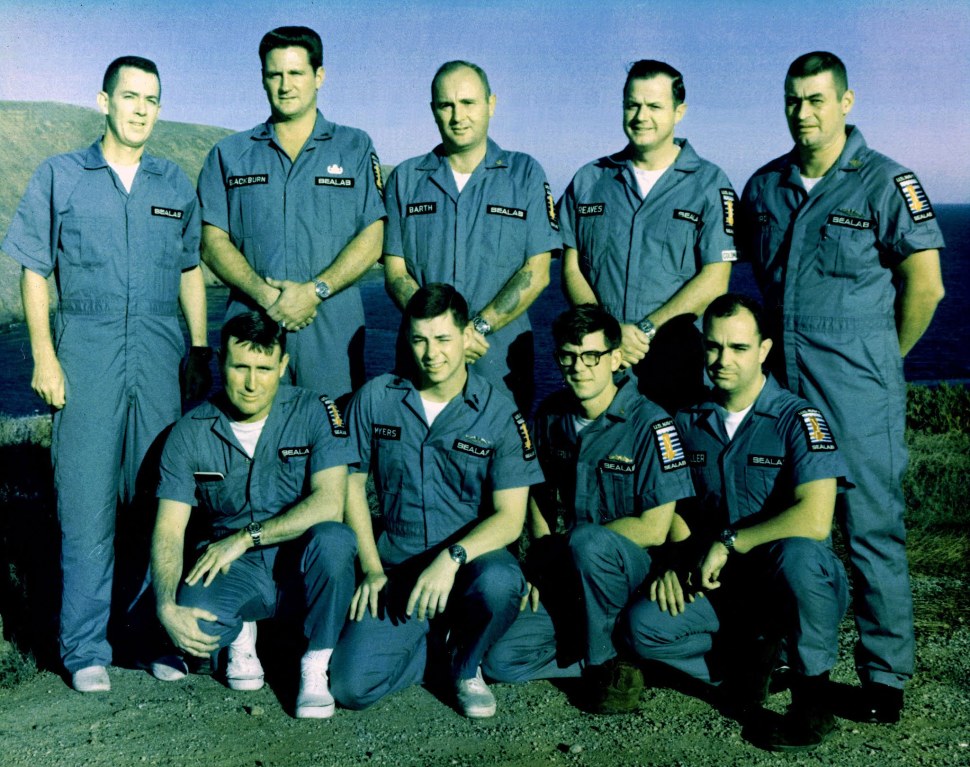
.
In this picture, Bob Barth (top center) and Berry Cannon (bottom left) were wearing Rolex diving watches, possibly Single Red Sea-Dwellers with valve.
The next picture shows Lieutenant Cyril Lafferty during a training session for SEALAB 3 in 1968. Lafferty was one of two British Royal Navy divers scheduled to live and work in the underwater habitat. The watch on his wrist is clearly a Doxa Sub.
In the early days of saturation diving, several watch brands were competing against each other to create the perfect watch for this new form of highly technical diving. Rolex with the Sea-Dweller, Doxa with the Conquistador and Omega with the Seamaster 600 Ploprof. The name Ploprof is short for Plongeur Professionnel which is French for professional diver.
While the valve was a quick fix that saved Rolex and Doxa from having to design a completely new watch, the Omega Ploprof was engineered from scratch for the specific purpose of saturation diving. It is said the watch was so tight, no helium could enter the case. In addition, the crystal was clamped between screwed bezel and case and could not pop off.

.
The Ploprof was tested by Comex divers and to a certain extent also by the Cousteau team. The picture below shows one of six Omega Seamaster 600 Ploprof prototypes delivered to Comex for testing purposes.

.
Coming back to SEALAB 3, it can be assumed that most Aquanauts had a variety of different diving watches at their disposal.
The US Navy SEALAB 3 experiment took place in February 1969. After lowering the habitat to its designated position at a depth of 610 ft/190 m off San Clemente Island in California, the underwater house was found to be leaking. The leaks were a serious problem as the supply of precious helium could run out quick and compromise the entire operation.
Four Aquanauts of Team One, namely Barth, Cannon, Blackburn and Reaves, made a rapid descent (4 ft/minute) to depth inside the deck decompression chamber of the diving support vessel and were lowered to the bottom in an attempt to save the habitat.
During the second attempt at fixing the leaks, Aquanaut Berry Cannon died as a result of an empty CO2 scrubber in his semi-closed circuit breathing apparatus. In consequence, the US Navy abandoned the SEALAB 3 experiment. To return to normal surface pressure, the three already pressurized Aquanauts had to endure nearly a full week of decompression.
The super interesting SEALAB documentary of the PBS American Experience series shows the very moment the three Aquanauts left the decompression chamber after the tragic event (47:05). In that scene, Bob Barth is seen wearing a DOXA Sub.
When I met Bob Barth at his house in Panama City, Florida in October 2017, he told me for SEALAB 3 they had received Rolex Sea-Dweller watches. During our extensive exchange, Bob did not mention Doxa at all.
Read more: The SEALAB Chronicles: A Journey To Panama City
Watch: American Experience: SEALAB (PBS)
.
A Doxa Sub 300 T Conquistador with rare silver dial can be seen in action in a 1973 US Navy documentary about the Deep Diving System Mark 1.
The picture below was taken from this documentary. It is truly profound as it shows the very moment the diver makes sure the valve on his Doxa Sub is closed before leaving the Personnel Transfer Capsule (PTC) and entering the water (13:15).
The full movie which offers a good overview of the US Navy’s professional diving program can be watched below.
.
The valve construction of the Doxa Sub 300 T Conquistador is considerably different in design compared to the valve used in first generation Rolex Sea-Dwellers of Ref. 1665.

.
The construction of the Rolex valve is simpler.
A closer look at the cross section depicted in the patent application from Nov. 6, 1967 reveals the Rolex valve was quite rudimentary and consisted of only three parts: The valve stem (6), a rubber o-ring seal (5) and a flat spring (10) .
The picture below shows an original Rolex valve set for Ref. 1665 (244 24-V50).
With the launch of the new Sea-Dweller Ref. 16660 aka Tripple Six in 1978, Rolex introduced a completely redesigned gas escape valve. The picture below compares Ref. 16660 (left) with Ref. 1665.
The 2nd generation Rolex valve looks very similar to the Doxa Sub 300 T Conquistador valve.
This new Rolex gas escape device was more refined than the first valve and probably much easier to maintain and to replace. The valve stem was now located in a separate body which was screwed into the watch case, similar to a crown tube. The new spring was spiral-shaped.
A closer look at the inside of a 1969 Doxa Sub 300 Conquistador suggests the Doxa valve could be almost identical to the 2nd generation Rolex valve.

.
This an interesting observation in two respects. First, if the valve was indeed co-developed by both brands as claimed by Doxa, why was the construction so different? And secondly, could it be that Doxa’s valve was the better approach and ultimately inspired Rolex to develop their 2nd generation valve?
It would be fascinating to explore this further. If a Doxa Sub 300 T Conquistador collector could provide detail pictures of the Doxa valve, I would be happy to publish them here.
.
Thoughts
The objective of this article was not to diminish Doxa in any way but rather to critically analyse what really occured in those days. I always liked the Doxa Subs and believe the Sub 300 T Conquistador is a super interesting and historically important watch.
The Conquistador was indeed the very first valve-equipped watch to be offered to the public. However, the story put forth concerning the co-development of the valve and the sharing of the patent is not very plausible in my opinion and has many question marks.
Here is what I believe occured. A number of different people came up with the very same idea to solve the pressure buildup inside the watches during saturation dives – around the same time. The installation of a valve was a logic solution as valves were relatively common in all sorts of diving equipment after all.
Remember, all these pioneers of the golden age of oceanic exploration were connected to each other. They were competitors to a certain degree but they also worked closely together to help solve each others problems. Bob Barth told me he knew Jacques Cousteau and his son Philippe as well as most of Cousteau’s team personally.
Dr. George Bond shared his idea of saturation diving with Jacques Cousteau who then tested Bond’s concept for the first time under real life conditions in 1963, long before SEALAB 1. The Cousteau team, on the other hand, made recommendations for SEALAB 2 on how to improve the living conditions inside the habitats.

.
After looking at all the available information, I believe Doxa developed their valve independently from Rolex. They possibly tried to patent their valve but since Rolex had already filed a patent application and the basic concept remained the same, Doxa had to concede the idea to Rolex.
In this context, the Conquistador could be explained as an attempt to benefit from the idea before the Swiss Pantent Office officially granted Rolex the patent.
This could be the reason why the Conquistador remained the only Doxa to feature a valve for many decades. If the valve was indeed shared, Doxa would have continued to sell and further develop the Conquistador, just like Rolex did with the Sea-Dweller.
The fact that less than ten Doxa Sub 300 T Conquistador have surfaced until today could be an indication that this model was taken off the market as soon as Rolex’s patent was granted.
I know, it is a lot of conjecture. It is what it is. Please let me know what you think and thank you for your interest.
Read more: SEALAB 2 – Rolex Submariners
.
Special thanks to Jason Heaton (@jasonheaton), Erik Strickland (@eriksstrickland) and lias Giannopoulos (@elio5).
.
History of the Rolex Sea-Dweller
The development of the Rolex Sea-Dweller goes hand in hand with man’s persistence of pushing the boundries and reaching never thought possible depths. The following infographic shows the historical context.
This graphic is available as a high quality print in two sizes:
- Regular small, 120cm x 68cm (47 x 26 inch): EUR 85.00 (plus shipping)
- Regular, 150cm x 85cm (59 x 33 inch): EUR 120.00 (plus shipping)
Limited: 50 pieces, numbered and signed by Bob Barth, the legendary US Navy Aquanaut who pioneered saturation diving during the famous SEALAB missions. Bob developed the idea for the Rolex Gas Escape Valve: Sold out

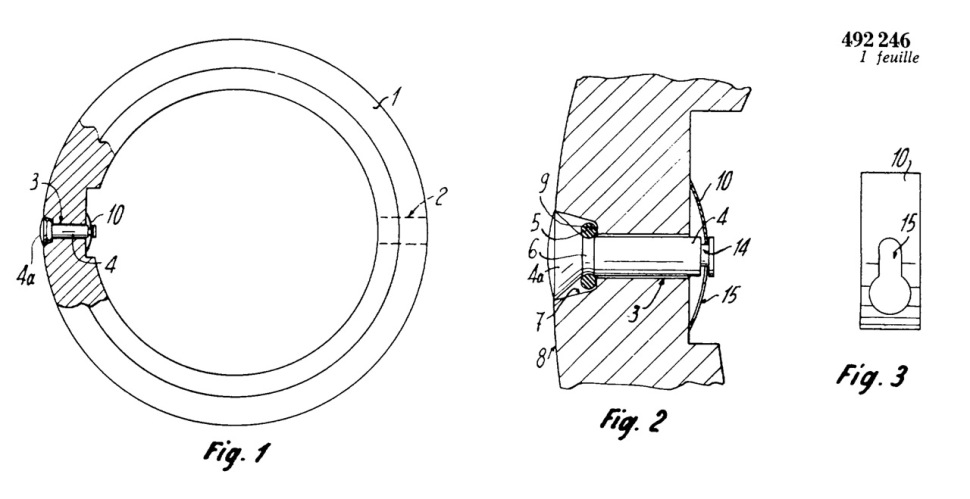

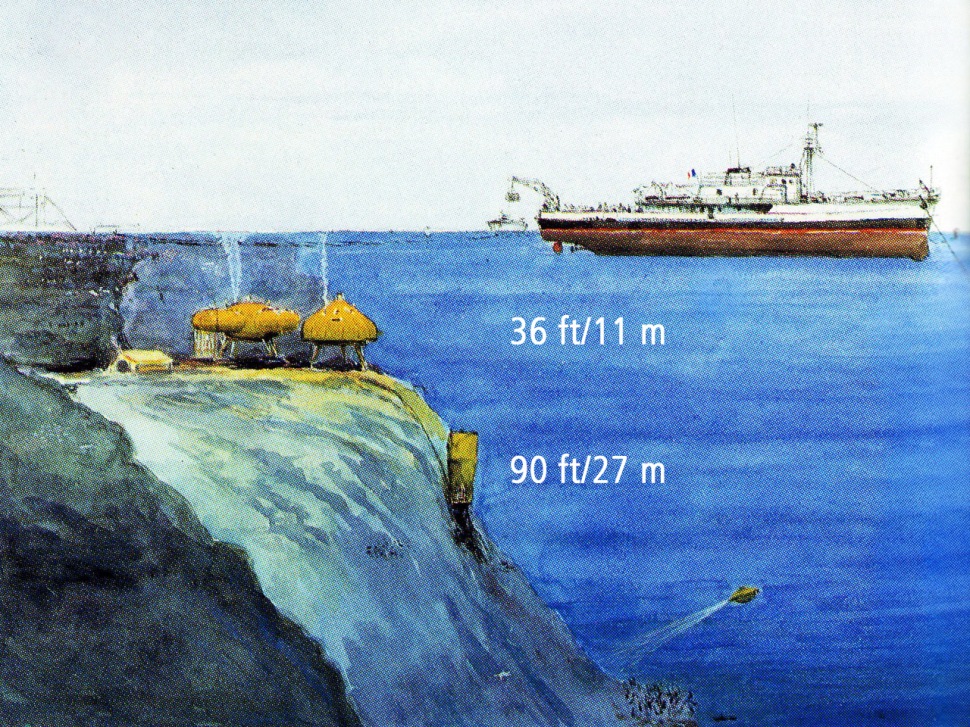


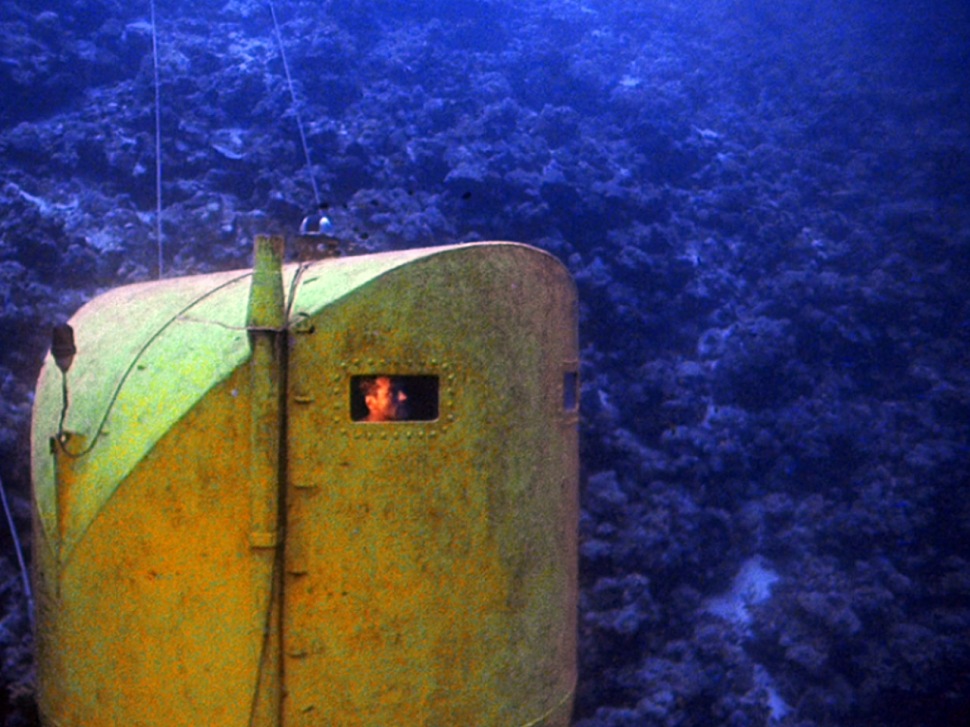














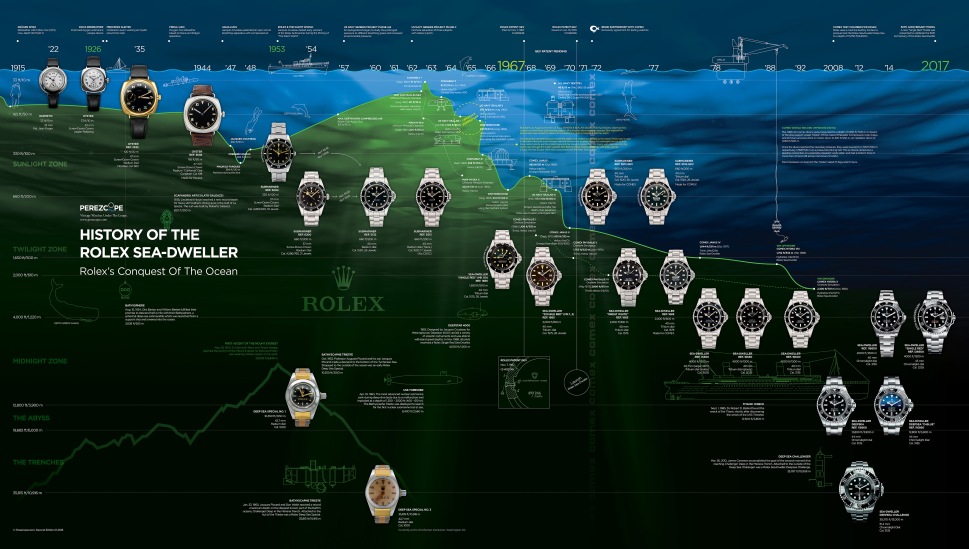
Interesting collection of information, I considered this before and came to my own conclusion that Doxa may had missed the boat in getting to the patent office. Sometimes people get bad advice on what is considered patent worthy and never file, considering Doxa came to market first and with a much better design tells us there is more to this story. Perhaps a visit to the patent office would solve the mystery. If Doxa did file but it was not granted as is your summation then the files should show that. As a side note love the work!
LikeLiked by 1 person
Wow, I love the depth you provide and the insight it passes along to the layperson. Please keep up these excellent articles. Thank you again for your efforts.
LikeLiked by 1 person